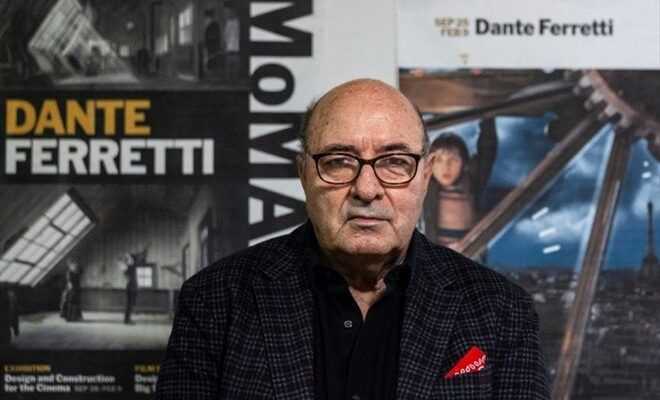The main entrance to the Cinecittà studios, November 19, 2021 in Rome (AFP / Laurent EMMANUEL, Marie-Laure MESSANA)
They are eternally associated with the golden age of Italian cinema, which has long since passed: crushed by Hollywood behemoths, the Cinecittà studios hope to regain their former glory thanks to funds from the European recovery plan.
The legendary Roman studios, passed under public control in 2017, will receive 260 million euros with the ambition to become by 2026 “an important European cinematographic center”, at least up to the competition of Pinewood and Shepperton nearly from London, Babelsberg in Germany and Korda in Hungary.
Their delay is significant. Unable to meet market demand – exponentially with series and TV programs – Cinecittà gives up 25 million euros in turnover per year, according to the business daily IlSole24ore.

The statue “La Venusia”, created in 1976 by Giantito Burchiellaro for the film “Le Casanova de Fellini”, in the gardens of Cinecittà, on November 19, 2021 (AFP / Laurent EMMANUEL, Marie-Laure MESSANA)
In the new plan, 172 million euros are foreseen for the adaptation of the production capacity – doubling the surface of the studios (which currently extend over 40 hectares) -, the creation of five new sets and the reconstruction and expansion of five others.
Twelve million euros will finance an indoor swimming pool for underwater filming, a theater with a 360 ° green screen and two sets for virtual reality with LED panels.
“For Cinecittà, this is really a unique opportunity because it brings together two situations that are difficult to reproduce: the recovery plan and a booming market,” Nicola Maccanico, director general of Cinecittà, told AFP. “It is in this market context that the idea of relaunching Cinecittà was born (…) with the idea of making it a reference pole for the new audiovisual production market in Europe”.

A permanent decor of ancient Rome in the Cinecittà studios, November 19, 2021 (AFP / Laurent EMMANUEL, Marie-Laure MESSANA)
If successful, “we would give it back the light that characterizes it and that it deserves”.
The moment is all the more propitious for the studios as the sector, in Italy, has the wind in its sails. According to the European Audiovisual Observatory in fact, in 2019, before the pandemic, Italy was the most prolific European country with 312 national productions, against 240 in France and 237 in Germany.
– Amusement park –
Formerly called “Hollywood on the Tiber”, Cinecittà – “the city of cinema” in Italian – has seen the birth of more than 3,000 films, including 51 Oscar winners. International giants like “Ben-Hur” (1959) by William Wyler or iconic films like “La Dolce Vita” (1960) by Federico Fellini were filmed there.

The Teatro 5 studio, Fellini’s favorite and the largest in Europe, in Cinecittà, November 19, 2021 (AFP / Laurent EMMANUEL, Marie-Laure MESSANA)
Inaugurated in 1937 on the southern outskirts of the capital as a Mussolinian propaganda machine, the studios have witnessed the various upheavals in the contemporary history of Italy: fascism, the Allied bombings of 1944, the use of the studios as housing for people displaced by the war, the economic “miracle” of the 1950s / 60s, then the decline.
Competition from television, the crisis in the Italian film industry and the abandonment of major international productions have relegated “the factory of dreams” to the hierarchy of major studios since the end of the 1960s. “Blockbusters” are sometimes there. filmed, like “Gangs of New York” by Martin Scorsese (2002), “Angels and Demons” by Ron Howard (2009) or “6 Underground” by Michael Bay (2019), but they are rare.

Decorator Dante Ferretti at Cinecittà, November 19, 2021 (AFP / Laurent EMMANUEL, Marie-Laure MESSANA)
To diversify its sources of income, Cinecittà has been welcoming the public since 2011. Groups of Italian and foreign tourists stroll between the studios, the most famous of which is the imposing Teatro 5 – Fellini’s favorite and the largest in Europe -, or stroll through the open-air settings of ancient Rome or 15th century Florence.
A cinema-themed amusement park also opened in the suburbs of Rome in 2014: Cinecittà World, designed by three-time Oscar-winning decorator Dante Ferretti.
“Some Hollywood studios are in the same state as Cinecittà, that is to say in a form of crisis, and the opening of the studios to the public is a way of balancing the accounts”, explains to AFP Jean Gili , critic and professor emeritus at the University of Paris 1 Panthéon-Sorbonne.
© 2021 AFP
Did you like this article ? Share it with your friends with the buttons below.




